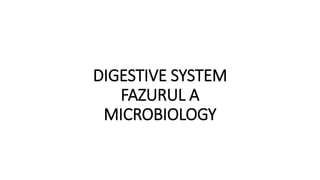
INTRO & SALIVARY GLAND.pptx
- 2. INTRODUCTION: • Digestion is defined as the process by which food is broken down into simple chemical substances that can be absorbed and used as nutrients by the body. • Substances must be broken into smaller particles, so that they can be absorbed into blood and distributed to various parts of the body for utilization. • Digestive process is accomplished by mechanical and enzymatic breakdown of food into simpler chemical compounds. • Digestive system plays the major role in the digestion and absorption of food substances.
- 3. The role of digestive system include: 1. Ingestion or consumption of food substances. 2. Breaking them into small particles. 3. Transport of small particles to different areas of the digestive tract. 4. Secretion of necessary enzymes and other substances for digestion. 5. Digestion of the food particles 6. Absorption of the digestive products (nutrients) 7. Removal of unwanted substances from the body.
- 5. • Digestive system is made up of gastrointestinal tract (GI tract) or alimentary canal and accessory organs, which help in the process of digestion and absorption. • GI tract is a tubular structure extending from the mouth up to anus, with a length of about 30 feet. • GI tract is formed by two types of organs: 1. Primary digestive organs. 2. Accessory digestive organs.
- 6. Primary Digestive Organs: • Primary digestive organs are the organs where actual digestion takes place. Primary digestive organs are: i. Mouth ii. Pharynx iii. Esophagus iv. Stomach v. Small intestine vi. Large intestine. Accessory Digestive Organs: • Accessory digestive organs are those which help primary digestive organs in the process of digestion. Accessory digestive organs are: i. Teeth ii. Tongue iii. Salivary glands iv. Exocrine part of pancreas v. Liver vi. Gallbladder
- 7. MOUTH: • Mouth is otherwise known as oral cavity or buccal cavity. • Digestive juice present in the mouth is saliva, which is secreted by the salivary glands. FUNCTIONS OF MOUTH: 1. Ingestion of food materials 2. Chewing the food and mixing it with saliva 3. Appreciation of taste of the food 4. Transfer of food (bolus) to the esophagus by swallowing 5. Role in speech 6. Social functions such as smiling and other expressions.
- 8. SALIVARY GLANDS: In humans, the saliva is secreted by three pairs of major (larger) salivary glands and some minor (small) salivary glands. MAJOR SALIVARY GLANDS: 1. Parotid glands 2. Submaxillary or submandibular glands 3. Sublingual glands. 1. Parotid Glands: Parotid glands are the largest of all salivary glands, situated at the side of the face just below and in front of the ear. Each gland weighs about 20 to 30 g in adults. Secretions from these glands are emptied into the oral cavity by Stensen duct. This duct is about 35 mm to 40 mm long
- 9. 2. Submaxillary Glands: Submaxillary glands or submandibular glands are located in submaxillary triangle, medial to mandible. Each gland weighs about 8 to 10 g. Saliva from these glands is emptied into the oral cavity by Wharton duct, which is about 40 mm long. The duct opens at the side of frenulum of tongue, by means of a small opening on the summit of papilla called caruncula sublingualis. 3. Sublingual Glands: Sublingual glands are the smallest salivary glands situated in the mucosa at the floor of the mouth. Each gland weighs about 2 to 3 g. Saliva from these glands is poured into 5 to 15 small ducts called ducts of Rivinus. These ducts open on small papillae beneath the tongue. One of the ducts is larger and it is called Bartholin duct. It drains the anterior part of the gland and opens on caruncula sublingualis near the opening of submaxillary duct.
- 11. MINOR SALIVARY GLANDS 1. Lingual Mucus Glands: Lingual mucus glands are situated in posterior one third of the tongue, behind circumvallate papillae and at the tip and margins of tongue. 2. Lingual Serous Glands: Lingual serous glands are located near circumvallate papillae and filiform papillae. 3. Buccal Glands: Buccal glands or molar glands are present between the mucus membrane and buccinator muscle. Four to five of these are larger and situated outside buccinator, around the terminal part of parotid duct. 4. Labial Glands: Labial glands are situated beneath the mucus membrane around the orifice of mouth. 5. Palatal Glands: Palatal glands are found beneath the mucus membrane of the soft palate.
- 12. CLASSIFICATION OF SALIVARY GLANDS: Salivary glands are classified into three types, based on the type of secretion: 1. Serous Glands: Serous glands are mainly made up of serous cells. These glands secrete thin and watery saliva. Parotid glands and lingual serous glands are the serous glands. 2. Mucus Glands: Mucus glands are mainly made up of mucus cells. These glands secrete thick, viscous saliva with high mucin content. Lingual mucus glands, buccal glands and palatal glands belong to this type. 3. Mixed Glands: Mixed glands are made up of both serous and mucus cells. Submandibular, sublingual and labial glands are the mixed glands
- 13. PROPERTIES AND COMPOSITION OF SALIVA „ PROPERTIES OF SALIVA: 1. Volume: 1000 mL to 1500 mL of saliva is secreted per day and it is approximately about 1 mL/minute. 2. Reaction: Mixed saliva from all the glands is slightly acidic with pH of 6.35 to 6.85 3. Specific gravity: It ranges between 1.002 and 1.012 4. Tonicity: Saliva is hypotonic to plasma.
- 15. FUNCTIONS OF SALIVARY GLANDS: 1.PREPARATION OF FOOD FOR SWALLOWING 2.APPRECIATION OF TASTE 3. DIGESTIVE FUNCTION 4. CLEANSING AND PROTECTIVE FUNCTIONS 5.ROLE IN SPEECH 6.EXCRETORY FUNCTION 7.REGULATION OF BODY TEMPERATURE 8.REGULATION OF WATER BALANCE